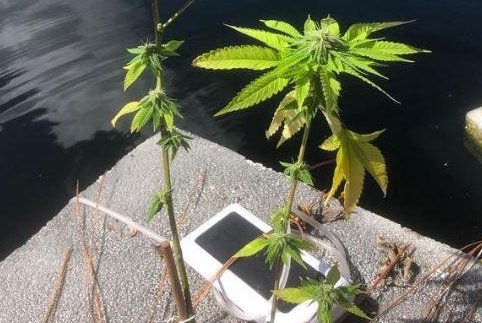
Researchers at South Florida State College study floating hemp plants for their ability to remove nitrogen and phosphorus from water. Photo courtesy of South Florida State College
ORLANDO, Fla., May 6 (UPI) -- Florida researchers have started to study how hemp plants could battle toxic algae blooms by cleaning polluted waterways.
If research results appear promising, they intend to grow large mats of hemp in key Florida waterways, potentially providing a source of industrial hemp fiber while also benefiting water quality.
"I'd like to see 10,000 acres of hemp mats growing in Lake Okeechobee to help restore the lake as the pristine bass fishery it once was," said Steven Edmonds, founder of Hemp4Water and a political science instructor at Valencia College in Orlando.
Edmonds teamed up with researchers at South Florida State College, near Tampa, on the project.
Edmonds has been an advocate for water quality and for cannabis legalization for years. He started Hemp4Water as a Facebook group in 2013 to encourage using hemp to improve water quality.
A severe bloom of red tide algae that year in southwest Florida killed more than 240 manatees, motivating Edmonds to seek a solution. Hemp is a non-intoxicating version of cannabis.
"I know that hemp growers spend a lot of money creating a water supply that's rich in nitrogen and phosphorus because cannabis needs that," Edmonds said. "It just makes sense to try this."
RELATED Products made from hemp-based plastics enter consumer market
So far, the project has not been funded, but help has come from staff members at South Florida State College. Martin Ecosystems, of Baton Rouge, La., donated growing containers and floating mats.
The college became involved when Kendall Carson, a program specialist in agriculture research there, overhead Edmonds talking about hemp's water cleansing abilities at a conference. She was seeking ideas for hemp research.
To conduct the research, staff members place hemp plants on the mats with some soil and clay. Roots are allowed to hang down into the water. The plants eventually suck up nitrogen and phosphorus, two nutrients that occur naturally.
RELATED Marijuana, hemp businesses bolster commercial real estate
After decades of farming, development and canal dredging, Lake Okeechobee and other Florida waters are overloaded with the nutrients.
Water from the lake travels to both Florida coasts through canals, or into the Everglades, carrying the nutrient pollution that feeds toxic blue-green algae and red tide algae.
Health problems associated with harmful algae cost the nation $22 million annually, according to a report from the University of Florida. Toxic algae, which usually float near shore or wash onto beaches and cause foul odors, kill fish and marine life.
A severe outbreak of red tide algae in southwest Florida in 2018 damaged the fishing and tourism industries. Blue-green algae in 2016 left harbors full of dead fish in the Indian River Lagoon along the Atlantic Coast.
The research will show how much nitrogen and phosphorus each plant removes from the water. Researchers then will calculate how much of the nutrients can be cleaned up by larger plantings.
Carson said students in biology, agriculture and environmental studies help to grow the plants and process data. A chemistry instructor plans to publish a paper on the results.
"You can grow the hemp and clean the water systems and harvest it and put it to good use," Carson said. "If every person with a lakefront home had a mat growing hemp, they could harvest it and clean up the water."
Plants have been many times used to clean polluted water and soil, said Paul Gray, a scientist with the non-profit Audubon Florida, which isn't involved in the project. He said the research could be valuable, but large-scale plantings would need a lot more study.
Gray pointed out that Lake Okeechobee has tremendous water volume even though it is very shallow. It is the 10th-largest lake in the United States at over 440,000 acres.
"Hydroponics for other plants have been used to clean up waterways, but trying to scale it up for Lake Okeechobee would be ambitious, and it would be hard to anchor it," Gray said.
"If you put 10,000 acres of hemp in the lake, that could cause other complications that would have to be studied, like blocked sunlight."
upi.com/7002562
No comments:
Post a Comment